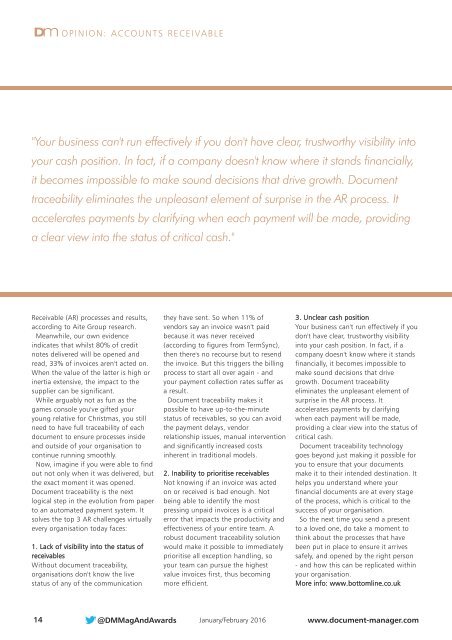Create successful ePaper yourself
Turn your PDF publications into a flip-book with our unique Google optimized e-Paper software.
Dm OPINION: ACCOUNTS RECEIVABLE<br />
"Your business can't run effectively if you don't have clear, trustworthy visibility into<br />
your cash position. In fact, if a company doesn't know where it stands financially,<br />
it becomes impossible to make sound decisions that drive growth. Document<br />
traceability eliminates the unpleasant element of surprise in the AR process. It<br />
accelerates payments by clarifying when each payment will be made, providing<br />
a clear view into the status of critical cash."<br />
Receivable (AR) processes and results,<br />
according to Aite Group research.<br />
Meanwhile, our own evidence<br />
indicates that whilst 80% of credit<br />
notes delivered will be opened and<br />
read, 33% of invoices aren't acted on.<br />
When the value of the latter is high or<br />
inertia extensive, the impact to the<br />
supplier can be significant.<br />
While arguably not as fun as the<br />
games console you've gifted your<br />
young relative for Christmas, you still<br />
need to have full traceability of each<br />
document to ensure processes inside<br />
and outside of your organisation to<br />
continue running smoothly.<br />
Now, imagine if you were able to find<br />
out not only when it was delivered, but<br />
the exact moment it was opened.<br />
Document traceability is the next<br />
logical step in the evolution from paper<br />
to an automated payment system. It<br />
solves the top 3 AR challenges virtually<br />
every organisation today faces:<br />
1. Lack of visibility into the status of<br />
receivables<br />
Without document traceability,<br />
organisations don't know the live<br />
status of any of the communication<br />
they have sent. So when 11% of<br />
vendors say an invoice wasn't paid<br />
because it was never received<br />
(according to figures from TermSync),<br />
then there's no recourse but to resend<br />
the invoice. But this triggers the billing<br />
process to start all over again - and<br />
your payment collection rates suffer as<br />
a result.<br />
Document traceability makes it<br />
possible to have up-to-the-minute<br />
status of receivables, so you can avoid<br />
the payment delays, vendor<br />
relationship issues, manual intervention<br />
and significantly increased costs<br />
inherent in traditional models.<br />
2. Inability to prioritise receivables<br />
Not knowing if an invoice was acted<br />
on or received is bad enough. Not<br />
being able to identify the most<br />
pressing unpaid invoices is a critical<br />
error that impacts the productivity and<br />
effectiveness of your entire team. A<br />
robust document traceability solution<br />
would make it possible to immediately<br />
prioritise all exception handling, so<br />
your team can pursue the highest<br />
value invoices first, thus becoming<br />
more efficient.<br />
3. Unclear cash position<br />
Your business can't run effectively if you<br />
don't have clear, trustworthy visibility<br />
into your cash position. In fact, if a<br />
company doesn't know where it stands<br />
financially, it becomes impossible to<br />
make sound decisions that drive<br />
growth. Document traceability<br />
eliminates the unpleasant element of<br />
surprise in the AR process. It<br />
accelerates payments by clarifying<br />
when each payment will be made,<br />
providing a clear view into the status of<br />
critical cash.<br />
Document traceability technology<br />
goes beyond just making it possible for<br />
you to ensure that your documents<br />
make it to their intended destination. It<br />
helps you understand where your<br />
financial documents are at every stage<br />
of the process, which is critical to the<br />
success of your organisation.<br />
So the next time you send a present<br />
to a loved one, do take a moment to<br />
think about the processes that have<br />
been put in place to ensure it arrives<br />
safely, and opened by the right person<br />
- and how this can be replicated within<br />
your organisation.<br />
More info: www.bottomline.co.uk<br />
14 @DMMagAndAwards January/February 2016 www.document-manager.com

















